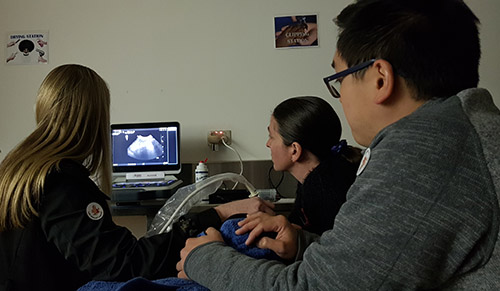Do you want to improve your skills in abdominal ultrasound but don’t know how to get started?
Dr Michelle Lau, a senior registrar in Veterinary Radiology at the University Veterinary Teaching Hospital Sydney, has offered some useful tips to those of you who are keen to make use of this amazing diagnostic tool which can offer so much without harm or trauma.
Michelle will be joining VetPrac as an educator at the Abdominal Ultrasound workshop in Brisbane on October 31 – November 1, 2020.
Michelle wanted to be a veterinarian since she was 7 years old! Her best friend at primary school mentioned it one day and the idea just stuck with her as she was growing up. Her interest in diagnostic imaging developed very early in her veterinary career.
During her internship year at QVS/Pet ER she did a lot of emergency night shifts where the veterinary team performed radiographs and brief ultrasounds overnight. She enjoyed it a lot (particularly ultrasound) and wanted to gain more knowledge in this field. Michelle soon realised that she wanted to specialise in diagnostic imaging.
For Michelle, the most enjoyable aspect of abdominal ultrasound is the amount of information that can be gained in a non-invasive, non-harmful way. She particularly loves it when ultrasound gives her useful information that complements other clinical findings (e.g. bloodwork) for a more definitive diagnosis.
Michelle encourages new grads to use every possible opportunity to practice ultrasound.
For example, briefly practice ultrasounding on animals that are already clipped for desexing. Michelle states “It sounds cliché, but continual practice is important. Also, don’t be afraid about not knowing things – this is completely normal, and you will get better with time”.
For general practitioners wishing to improve their skills in abdominal ultrasound Michelle suggests doing continuing education (e.g. VetPrac ultrasound courses, the long-distance graduate certificate in ultrasound offered by Melbourne Uni), reading textbooks (e.g. Small Animal Diagnostic Ultrasound) and continually practising ultrasound in your practice.

Michelle does not deny that performing abdominal ultrasound can be challenging. Michelle finds that ultrasounding the cranial abdomen in big, deep chested dogs is always a challenge. And sometimes she finds it hard to locate the right adrenal gland.
Some practical tips that Michelle learnt from experience relate to clipping adequately and sedation. ” It’s better to clip more fur off than clipping too little; avoid dousing the animal in alcohol and gel and then realising you need to now clip off wet, goopy fur. You may need to clip further cranially than you think you’ll need to, particularly in big and deep chested dogs. Where it’s possible and safe to do so, sedating patients makes it a lot easier to ultrasound.”
When Michelle is not working at perfecting her ultrasound skills, she loves to exercise (especially running!), rock climb/boulder and hike. In her downtime, she enjoys reading, hanging out with family and friends, and cuddles and walks with her dog Rocky, an 8 yo Foxy with a lot of personality.
So, if you’d like to begin a journey to unlock the secrets of abdominal ultrasound, and find that elusive right adrenal gland, why not join Michelle at the VetPrac abdominal ultrasound workshop.
Registrations are open for these Abdominal Ultrasound workshops
Click on the images for more details



